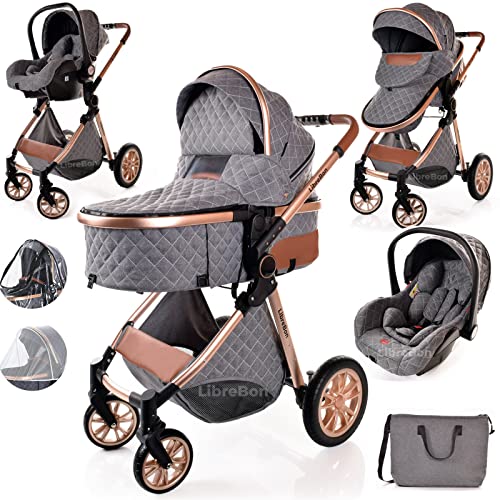Transitioning from Pram to Stroller: A Comprehensive Guide for Parents
Navigating the world of baby gear can be frustrating for brand-new moms and dads, specifically when it comes to choosing in between prams and strollers. Both serve vital functions, however they are designed for different requirements and phases of a child's advancement. This post intends to inform parents about the transition from prams to strollers, detailing the advantages and considerations while offering useful ideas.
Understanding Prams and Strollers
Before diving into their distinctions, it's essential to understand what makes up a pram and a stroller.
Prams:
A pram, short for perambulator, is usually designed for babies as much as around six months old. It includes a flat, cushioned sleeping area and is primarily meant for transferring extremely young kids. Prams are designed for convenience and safety, as newborns need to lie flat to support their spine and organs.
Strollers:
Strollers, or pushchairs, are designed for slightly older kids who can stay up unaided. They are available in different designs and setups, from lightweight umbrella strollers to heavier-duty models appropriate for rough surfaces. Strollers are more versatile and simpler to navigate in crowded areas, making them a popular option for active households.
Benefits of Transitioning from Pram to Stroller
- Increased Mobility and Convenience
Strollers are generally lighter and more compact than prams, making them simpler to steer through shops, public transportation, and crowded areas. Many strollers can fold easily, enabling hassle-free storage. - Flexibility for Different Activities
Modern strollers often come with several configurations and can accommodate various activities, including running, outside experiences, and shopping journeys. They can likewise adjust to fit kids of different ages and weights. - Enhanced Child Comfort and Safety
Lots of strollers now come geared up with innovative security functions, such as five-point harnesses and reclining seats, guaranteeing that older babies and young children stay comfortable and safe throughout getaways. - Economical Solution
Rather than acquiring both a pram and a stroller, households can invest in a premium stroller that fulfills the needs of their growing child, potentially saving money in the long run.
When to Make the Transition
The shift from a pram to a stroller normally happens when the kid reaches around 6 to 7 months of age or when they can sit up unassisted. Nevertheless, several elements can influence this transition, consisting of:
- Child's Development: If the child shows indications of wishing to explore their environments, it may be time to switch to a stroller.
- Household Lifestyle: Active families might require a stroller faster to accommodate getaways and travel.
- Convenience: Observe the child's comfort level. If they appear confined in a pram or are ending up being more active, it's time to think about a stroller.
Selecting the Right Stroller
Picking the ideal stroller needs careful factor to consider of numerous elements:
| Factor | Description |
|---|---|
| Safety Features | Search for sturdy building and construction, effective brakes, and harness systems. |
| Weight and Foldability | Pick a lightweight stroller that is simple to fold and transport. |
| Age Appropriateness | Make sure the stroller is suited for your child's age, weight, and height. |
| Maneuverability | Evaluate how quickly the stroller relocations and turns, specifically in crowded areas. |
| Storage Space | Consider the storage capacity beneath the stroller and the size when folded. |
| Adjustability | Search for strollers with adjustable features, such as seat recline and handle height. |
Frequently asked questions about Transitioning from Pram to Stroller
Q: Is it required to switch to a stroller?A: While it's not necessary, switching to a stroller usually offers more flexibility and ease for both parent and kid as they grow. Q: What features must I prioritize
in a stroller?A: Prioritize safety features, weight, foldability, and storage capacity based on your way of life and activities with your child. Q: Can I utilize a stroller for newborns?A: Some strollers can accommodate baby safety seat or
have flat reclining seats, making them suitable for
newborns. Always examine the maker's guidelines. Q: How can I guarantee my child is comfortable in a stroller?A: Look for strollers with cushioned seats, numerous recline positions, and adjustable leg rests to accommodate your child's convenience. Q: What are the best types of strollers available?A: Popular types include umbrella strollers, running strollers, travel system strollers, and convertible strollers, each dealing with variousrequirements. Pushchair Offers for a Smooth Transition Test Out Different Models: Before dedicating to a purchase, physically test various strollers to see which one suits both you and your child best. Include Your Child:
If they are old enough, permit your
kid to check out different strollers to see which they discover most comfortable. Read Reviews: Consider taking a look at online reviews and suggestions from other moms and dads to much better notify your choice
. Prepare for Storage and Transport: Factor in how the stroller will fit into your vehicle or home storage area to prevent future hassles.
- Assess Your Activities: Think about where and how you plan to utilize the stroller-- metropolitan areas might need a different type compared to rural or off-road settings.
- Transitioning from a pram to a stroller is a crucial milestone in a kid's life and a significant choice for moms and dads. By comprehending the differences and
benefits of each, moms and dads can make educated options that will support their family's way of life and their kid's development. Armed with the ideal information, moms and dads can confidently navigate this transition and
guarantee that their kid is safe, comfy, and all set for all the experiences ahead.

